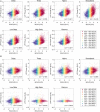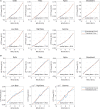The Relationship Between Local Field Potentials and the Blood-Oxygenation-Level Dependent MRI Signal Can Be Non-linear
- PMID: 31708727
- PMCID: PMC6823197
- DOI: 10.3389/fnins.2019.01126
The Relationship Between Local Field Potentials and the Blood-Oxygenation-Level Dependent MRI Signal Can Be Non-linear
Abstract
Functional magnetic resonance imaging (fMRI) is currently one of the most important neuroimaging methods in neuroscience. The image contrast in fMRI relies on the blood-oxygenation-level dependent (BOLD) signal, which indirectly reflects neural activity through neurovascular coupling. Because the mechanism that links the BOLD signal to neural activities involves multiple complicated processes, where neural activity, regional metabolism, hemodynamics, and the BOLD signal are all inter-connected, understanding the quantitative relationship between the BOLD signal and the underlying neural activities is crucial for interpreting fMRI data. Simultaneous local field potential (LFP) and fMRI recordings provide a method to study neurovascular coupling. There were a few studies that have shown non-linearities in stimulus related responses, but whether there is any non-linearity in LFP-BOLD relationship at rest has not been specifically quantified. In this study, we analyzed the simultaneous LFP and resting state-fMRI data acquired from rodents, and found that the relationship between LFP and BOLD is non-linear under isoflurane (ISO) anesthesia, but linear under dexmedetomidine (DMED) anesthesia. Subsequent analysis suggests that such non-linearity may come from the non-Gaussian distribution of LFP power and switching from LFP power to LFP amplitude can alleviate the problem to a degree. We also confirmed that, despite the non-linearity in the mean LFP-BOLD curve, the Pearson correlation between the two signals is relatively unaffected.
Keywords: BOLD; correlation; electrophysiology; fMRI; local field potentials; neurovascular coupling; non-linearity.
Copyright © 2019 Zhang, Pan and Keilholz.
Figures











Similar articles
-
Broadband local field potentials correlate with spontaneous fluctuations in functional magnetic resonance imaging signals in the rat somatosensory cortex under isoflurane anesthesia.Brain Connect. 2011;1(2):119-31. doi: 10.1089/brain.2011.0014. Brain Connect. 2011. PMID: 22433008 Free PMC article.
-
Complex relationship between BOLD-fMRI and electrophysiological signals in different olfactory bulb layers.Neuroimage. 2014 Jul 15;95:29-38. doi: 10.1016/j.neuroimage.2014.03.052. Epub 2014 Mar 25. Neuroimage. 2014. PMID: 24675646
-
Phase-amplitude coupling and infraslow (<1 Hz) frequencies in the rat brain: relationship to resting state fMRI.Front Integr Neurosci. 2014 May 27;8:41. doi: 10.3389/fnint.2014.00041. eCollection 2014. Front Integr Neurosci. 2014. PMID: 24904325 Free PMC article.
-
The neural basis of the blood-oxygen-level-dependent functional magnetic resonance imaging signal.Philos Trans R Soc Lond B Biol Sci. 2002 Aug 29;357(1424):1003-37. doi: 10.1098/rstb.2002.1114. Philos Trans R Soc Lond B Biol Sci. 2002. PMID: 12217171 Free PMC article. Review.
-
Submillimeter-resolution fMRI: Toward understanding local neural processing.Prog Brain Res. 2016;225:123-52. doi: 10.1016/bs.pbr.2016.03.003. Epub 2016 Apr 1. Prog Brain Res. 2016. PMID: 27130414 Review.
Cited by
-
Lysergic Acid Diethylamide Alters the Effects of Brain Stimulation in Rodents.Psychedelic Med (New Rochelle). 2023 Mar 13;1(1):43-53. doi: 10.1089/psymed.2022.0014. eCollection 2023 Mar. Psychedelic Med (New Rochelle). 2023. PMID: 40047011 Free PMC article.
-
Contribution of animal models toward understanding resting state functional connectivity.Neuroimage. 2021 Dec 15;245:118630. doi: 10.1016/j.neuroimage.2021.118630. Epub 2021 Oct 10. Neuroimage. 2021. PMID: 34644593 Free PMC article. Review.
-
Relationship Between Basic Properties of BOLD Fluctuations and Calculated Metrics of Complexity in the Human Connectome Project.Front Neurosci. 2020 Sep 15;14:550923. doi: 10.3389/fnins.2020.550923. eCollection 2020. Front Neurosci. 2020. PMID: 33041756 Free PMC article.
References
Grants and funding
LinkOut - more resources
Full Text Sources

